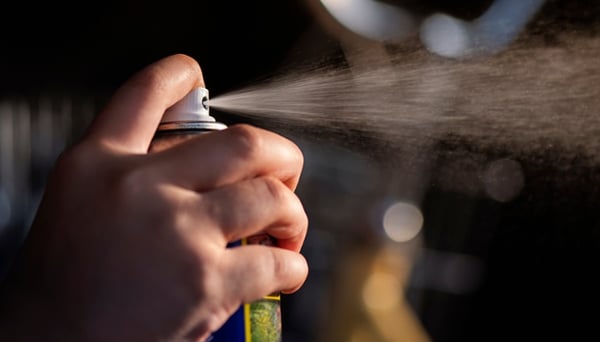Aerosol cans dispense a huge range of substances in various forms — pastes, foams, wet or dry sprays, gels and creams. Not only are the little cans airtight so the substance inside won’t evaporate, they also have a long shelf-life, which makes them a convenient option for workplace chemicals. But even though the aerosol cans are ready to use at the touch of a button, nearly all aerosol cans are Class 2.1 Flammable Gases and dangerous goods.
Many workplaces and domestic households don’t give aerosols the respect they deserve and remain seemingly unaware of the numerous accidents, injuries and dangerous events caused by storing and handling aerosols incorrectly. This blog provides important information about aerosol safety in the workplace, looking at general hazards and key recommendations for reducing accidents and incidents involving aerosols.
TIP: Download our free eBook Gas Cylinder Storage: compliance and safety requirements to learn how to apply a risk management methodology at your worksite to control the hazards associated with compressed gases and aerosols.
Aerosol Hazards
Aerosol cans present two key layers of hazards. Apart from the chemical properties of the actual substance being housed in the can, the canisters themselves can become projectiles as well as a waste hazard at the end of their shelf-life.
Aerosol sprays post risk to workplaces due to their:
- Health hazards
- Physiochemical hazards
Health Hazards
Despite being filled with spray paints, insecticides, automotive sprays, lubricants, heavy duty cleaners, adhesives, and other hazardous substances; many workers seem to forget that the contents of aerosol cans are potentially dangerous chemicals. It is essential that staff have a full understanding of the chemical properties of the substances they use at a worksite including those contained in aerosol cans.
While aerosols may be a common sight in both homes and businesses, many of these cans contain toxic chemicals that can harm human health. Ingredients such as Xylene (also known as Dimethyl Benzene) can cause a range of health issues from headaches and breathing difficulties to fatalities. The degree of harm caused these substances depends on the concentration of the chemical in the aerosol can and the duration of exposure.

Aerosols in the workplace pose a range of complex hazards.
Physiochemical Hazards
Physiochemical hazards relate to the way a substance is used, stored or handled. This also includes the storage containers and other dangerous goods that might come into contact with the substance.
For example: a punctured or ruptured aerosol may become a dangerous projectile, with many recorded accidents where staff were seriously injured after being hit by an airborne can.
Aerosol cans which become overheated have also been known to ignite and explode with many workers suffering second and third degree burns, plus other terrible injuries. The worker can also be covered in shrapnel from the can as well as covered in the hazardous substance contained inside — such as burning paint.
Considering Safe Aerosol Disposal
Aerosols can also produce hazardous waste, particularly when the canister is unusable because the spray nozzle is defective or broken. The chemical liquids and vapours that remain in the can could create a fire or explosion, as well as present a toxic exposure risk to site personnel. Your risk management plan should have provision for the waste management program of these Class 2.1 Flammable Gases.
REMEMBER: Even empty aerosols must be treated with care, just as you would with a full or partially used aerosol spray. If the aerosol isn’t disposed of in the correct way, they can create a range of serious hazards during the disposal process.
Aerosols are Dangerous Goods
Whether your worksite uses or carries aerosol spray paint, deodorant or automotive lubricant, the aerosol can is considered Class 2 Dangerous Goods. To reduce the risks associated with aerosol cans, it’s essential that you:
1. Include Aerosols in Your Risk Assessment
Don’t overlook aerosol cans in the hazard identification step of your onsite chemical risk assessment. Even a single can of lubricant or spray paint is a hazard and must be factored into your Safety Management Plan.
Aerosols may also be incompatible with other chemicals at your site, so it’s important that each particular product is considered in your risk assessment.
2. Read the Safety Data Sheet (SDS) for Each Aerosol
Make sure you consult the Safety Data Sheets (SDSs) for each aerosol can so that you fully understand the chemical properties of the substances contained inside. A copy of the SDS will need to be included in your register of Hazardous Chemicals, and if your site exceeds aggregate threshold quantities (consult the WHS Regulation in your state or territory) they must also be included in the Manifest.
REMEMBER: Giving your staff and contractors access to your Safety Data Sheets is essential for maintaining aerosol safety. Read our post on how to understand SDS to find out more about the hazards and safety precautions contained in these documents.
3. Train Your Staff in Aerosol Safety
Staff training and providing adequate supervision is key to creating a safe work environment.
In addition to aerosols being included in safety inductions and chemical training, it’s important to continually raise safety awareness about these dangerous goods so staff don’t forget the information — or become complacent.
You can easily introduce safety advice for aerosol cans at toolbox talks, staff meetings and safety forums.

Care must be taken to ensure that aerosols are not sprayed near any type of ignition source, including sources of heat and naked flames.
Ensuring your staff are suitably trained is a requirement of many Australian Standards including AS 4332 - The storage and handling of gases in cylinders. But your primary responsibilities are legislated by both the Workplace Health and Safety (WHS) Act and Regulation current in your state or territory.
Your obligations for safety training include:
- Delivering a safety induction to employees or contractors before they commence working for you.
- Providing workers with information about the risks and hazards they face on the worksite.
- Making sure workers understand how to do their job safely as well as their individual responsibilities according to the law.
- Supervising your staff and delivering remedial actions and training if they are not following safety instructions or aren’t fully competent in their duties.
Storage for Class 2 Gases, inculding aerosols, must meet compliance requirements so that all hazards are controlled. The Premium Range from Storemasta offers configurable storage for your aerosols or gas cylinders, with segregation still applying.
Some aerosol training essentials include guidance on:
- Identifying potential ignition sources present on the worksite (heat, direct sunlight, heaters, ovens, hot plates, gas pilot lights, static electricity, matches, lighters, exposed incandescent material, welding and cutting activities)
- Not smoking when using an aerosol (or immediately afterwards).
- Not piercing an aerosol canister because seemingly empty canisters can explode.
- The safe disposal of the canisters.
- Not leaving aerosol cans in vehicles (especially the glovebox) as temperatures inside a vehicle can increase quickly.
- Using aerosols in a well-ventilated area and always use appropriate PPE (masks, face shields, gloves, protective clothing).
- Not spraying aerosols near a naked flame, fire or source of ignition as this could cause an explosion.
The most effective safety training is delivered using a range of different methods (and at regular intervals). It’s more than job specific training, it’s about building safety awareness.
Training your staff in aerosol safety can only be achieved through a combination of:
- Providing safety induction training that introduces workers to the range of hazards present on the worksite and the way aerosol cans contribute to accidents, fires and explosions. Workers also learn site rules, restricted areas and banned substances.
- Giving staff job specific training that includes procedures for introducing new equipment and hazardous substances onto the worksite — eg, reviewing Safety Data Sheets (SDSs) and purchase approvals.
- Supervising staff and work areas and ensuring that aerosol cans are being used safely, not left lying around work benches or production areas, and are stored correctly.
- Creating a safety culture by delivering regular toolbox talks and safety forums that build aerosol safety awareness.
- Providing essential PPE and compliant aerosol cages so staff have a safe working environment and the equipment they need to carry out their jobs.
REMEMBER: In addition to safety aerosol training, it’s also important to create standard operating procedures for your aerosol storage cages and handling equipment. This will ensure that staff know how to properly operate and maintain the equipment, so they can stay safe and keep your workplace compliant.
4. Store Aerosols Correctly
To control the many hazards associated with aerosol sprays, you must remember to keep your aerosol cans in dedicated storage suitable for the chemical.
Our range of Australian-made aerosol cages are an ideal storage option because they are designed and constructed to control the health hazards (nausea, breathing difficulties) and physiochemical hazards (explosion, chemical incompatibilities) associated with the aerosol spray.
Storing aerosols in a compliant cage made to Australian Standards will reduce aerosol hazards in your workplace.
- Manufactured in accordance with AS 4332 - The storage and handling of gases in cylinders
- Designed for the correct height of the cans
- Constructed from heavy-duty componentry that offers safe projectile protection
- Built with perforated walls to allow the natural movement of air and comply with ventilation standards
- Finished with a corrosion-resistant 2-PACK polyurethane coating
- Fixed with mandatory placards and warning signs
IMPORTANT: Using a dedicated aerosol cage makes housekeeping and safe work practices easier for staff. The cages are constructed with a green powder-coating, with the applicable dangerous goods and hazard signage clearly visible on the cage door. This makes it a quick and simple task to return aerosols to the correct storage cage after they have been used.
Aerosol Safety and Storage Tips
Aerosols pose a number if hazards upon people and property in the workplace. To ensure that your workplace is safe and compliant, it is important that you identify and assess the risks associated with aerosols and control them in an effective manner. If you would like more information on how to manage the risks associated with aerosols in the workplace, download our free eBook today to learn more.
Talarah has been working for Storemasta for many years, specialising in Marketing, Customer Service and Risk Management Solutions.



